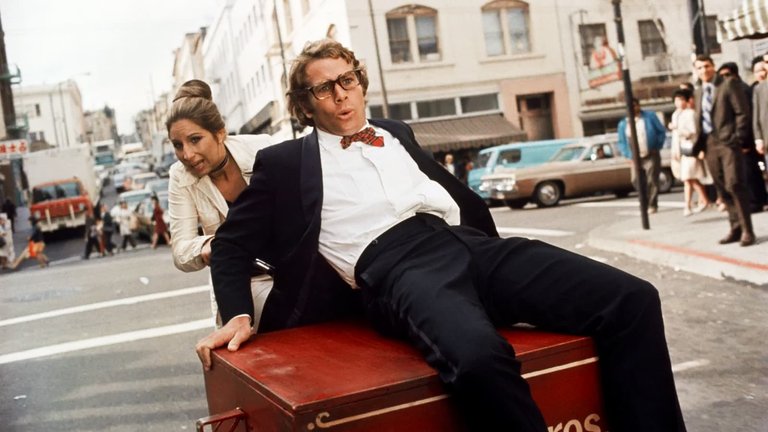Film Review: What's Up, Doc? (1972)

The New Hollywood era, synonymous with gritty, style-driven dramas like Taxi Driver or The Godfather, was not typically associated with broad, crowd-pleasing comedies. Yet Peter Bogdanovich, one of the movement’s most eclectic directors, produced a film that defied these expectations. What’s Up, Doc?, released in 1972, stands as Bogdanovich’s most accessible and popular work, a riotous homage to the screwball comedies of Classic Hollywood. Amidst an industry obsessed with innovation and antiheroes, What’s Up, Doc? embraced the past with gleeful abandon, proving that nostalgia and slapstick could still captivate mainstream audiences.
The film’s DNA traces directly to Howard Hawks, whose 1938 Bringing Up Baby provided the blueprint. Bogdanovich, inspired by a conversation with Hawks, tasked screenwriters Buck Henry, David Newman, and Robert Benton with crafting a loose remake of that classic. Ryan O’Neal’s Howard Bannister—a musicologist competing for a research grant—echoes Cary Grant’s neurotic David Huxley, while Barbra Streisand’s free-spirited Judy Maxwell mirrors Katharine Hepburn’s antics. Yet Bogdanovich’s vision expands beyond imitation, weaving in references to Casablanca, Cole Porter’s jazz-age melodies, and even Bugs Bunny cartoons (the title nods to a 1940s Looney Tunes short). The result is a pastiche that honours its forebears while injecting 1970s irreverence.
The plot unfolds in San Francisco, where Howard’s quest for a musicology grant collides with a series of escalating farces. His luggage—containing crucial rock samples—is mistaken for three others: a diamond-laden bag carried by matriarch Mrs. Van Hoskins (Mabel Robertson), classified documents belonging to a government agent (Michael Murphy), and Judy’s suitcase full of clothes and underwear. The mix-ups spark slapstick chaos, exacerbated by the presence of Hugh Simon (Kenneth Mars), a flamboyant Croatian musicologist parodying critic John Simon. Bogdanovich layers misunderstandings, romantic tension, and a heist subplot, creating a frenetic comedy that thrives on its characters’ incompetence and the city’s labyrinthine energy.
San Francisco’s streets serve as a backdrop for Bogdanovich’s love letter to mid-20th-century pop culture. Cole Porter’s songs, performed by Streisand with infectious zest, evoke the Golden Age of musicals, while the film’s title and visual gags riff on Bugs Bunny’s anarchic spirit. Bogdanovich also nods to Casablanca in the hotel-based espionage subplot, and the climactic car chase—a parody of Bullitt’s iconic sequence—blends homage with self-aware parody. These touches ground the film in a rich cinematic heritage, positioning it as both a revival and a critique of Classic Hollywood tropes.
While Bogdanovich’s reverence for screwball comedy is evident, the film’s first half falters under its reliance on Hawksian dialogue and contrivances. The jokes feel laboured, the set pieces overly stagey. It is only in the second half, when slapstick dominates, that the film truly finds its rhythm. The car chase becomes a gleeful celebration of physical comedy, its energy and absurdity overshadowing the earlier verbal sparring. This shift suggests Bogdanovich’s strengths lay not in replicating Hawks’ wit but in embracing the visceral chaos of farce.
Ryan O’Neal, fresh off Love Story’s tearful Oscar win, is a puzzling choice as Howard. His charmless, deadpan delivery lacks Grant’s suave wit, and his character’s academic rigidity comes off as unlikable rather than endearing. The film even pokes fun at O’Neal’s star persona: Howard mocks Love Story, underscoring the dissonance between O’Neal’s screen image and his role here. Streisand, meanwhile, compensates with her trademark energy, though her Judy is less memorable than Hepburn’s iconic counterpart.
The true stars are the supporting players. Madeline Kahn, in her film debut, delivers a tour de force as Howard’s domineering fiancée, Eunice Burns—a role that earned her an Oscar nomination. Her over-the-top tantrums and Shakespearean histrionics overshadow O’Neal’s lead. Kenneth Mars, as the pretentious Hugh Simon, channels the vitriol of critic John Simon (a personal vendetta among the writers), though the joke is too niche to resonate with modern audiences. Even minor roles, like the hotel’s bumbling thieves, crackle with Bogdanovich’s affection for character-driven chaos.
What’s Up, Doc? became a box-office sensation, but its success hinged more on O’Neal and Streisand’s star wattage than Bogdanovich’s direction. While far from a comedy masterpiece, it remains a lively, if uneven, entry in the genre. Its nostalgic charm and Bogdanovich’s affection for Hollywood’s past ensure it retains a cult following. Yet, the film’s true value lies in its ambition: a director’s earnest attempt to revive the spirit of Classic cinema in an era that preferred to bury it.
RATING: 6/10 (++)
Blog in Croatian https://draxblog.com
Blog in English https://draxreview.wordpress.com/
InLeo blog https://inleo.io/@drax.leo
Hiveonboard: https://hiveonboard.com?ref=drax
InLeo: https://inleo.io/signup?referral=drax.leo
Rising Star game: https://www.risingstargame.com?referrer=drax
1Inch: https://1inch.exchange/#/r/0x83823d8CCB74F828148258BB4457642124b1328e
BTC donations: 1EWxiMiP6iiG9rger3NuUSd6HByaxQWafG
ETH donations: 0xB305F144323b99e6f8b1d66f5D7DE78B498C32A7
BCH donations: qpvxw0jax79lhmvlgcldkzpqanf03r9cjv8y6gtmk9
Posted Using INLEO